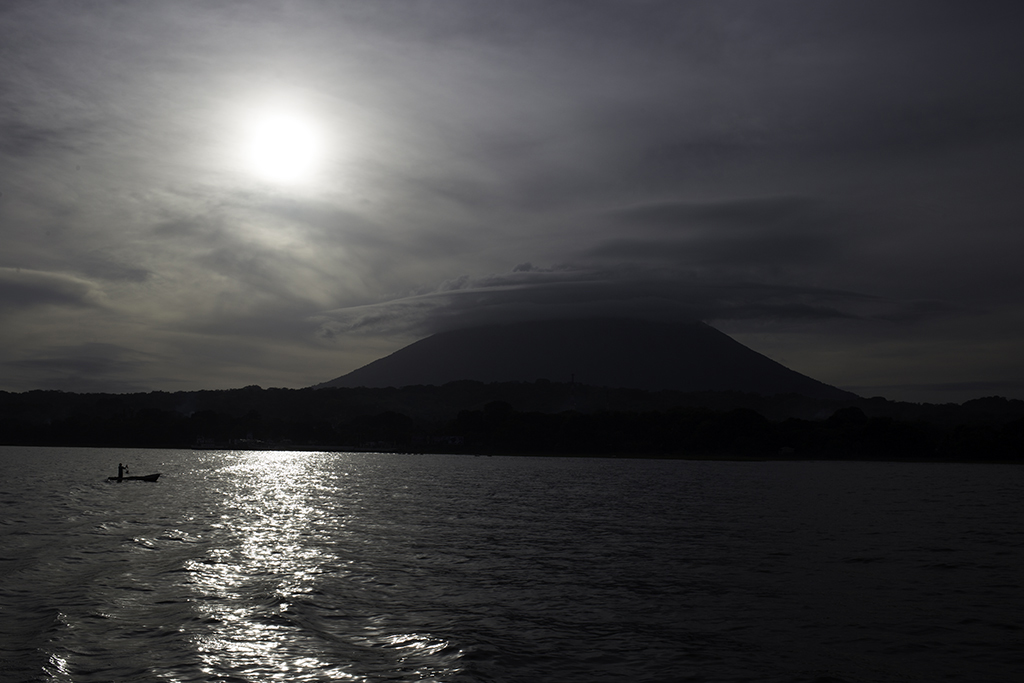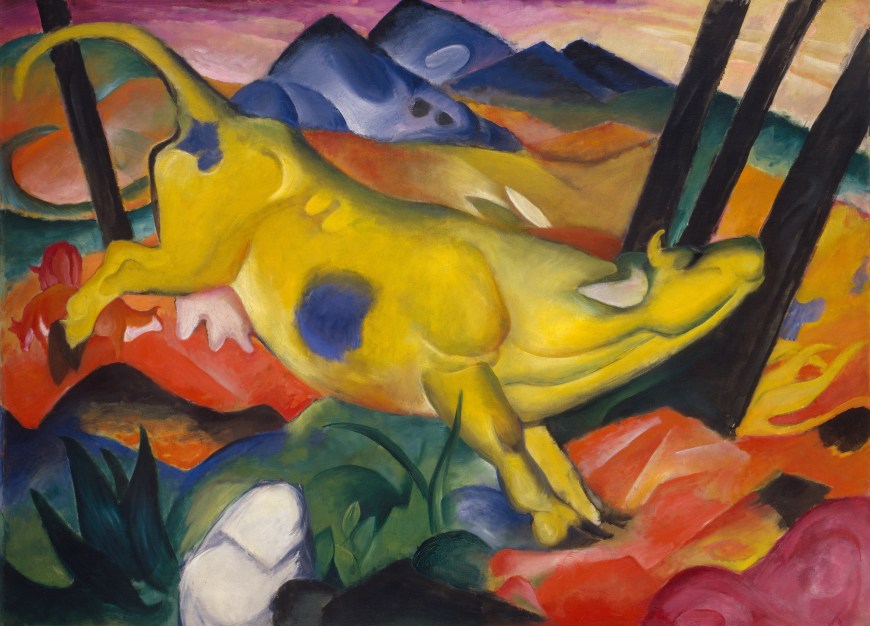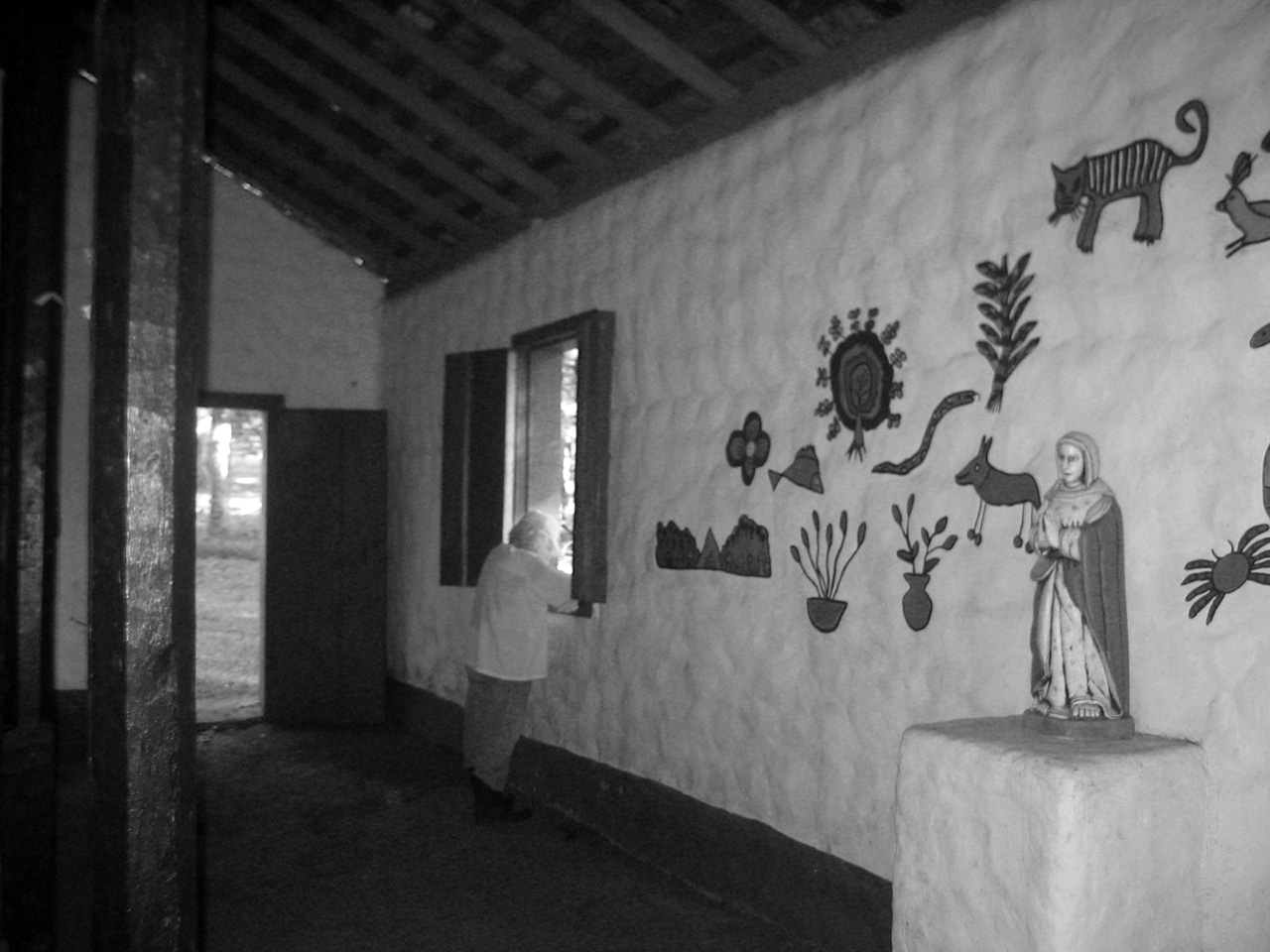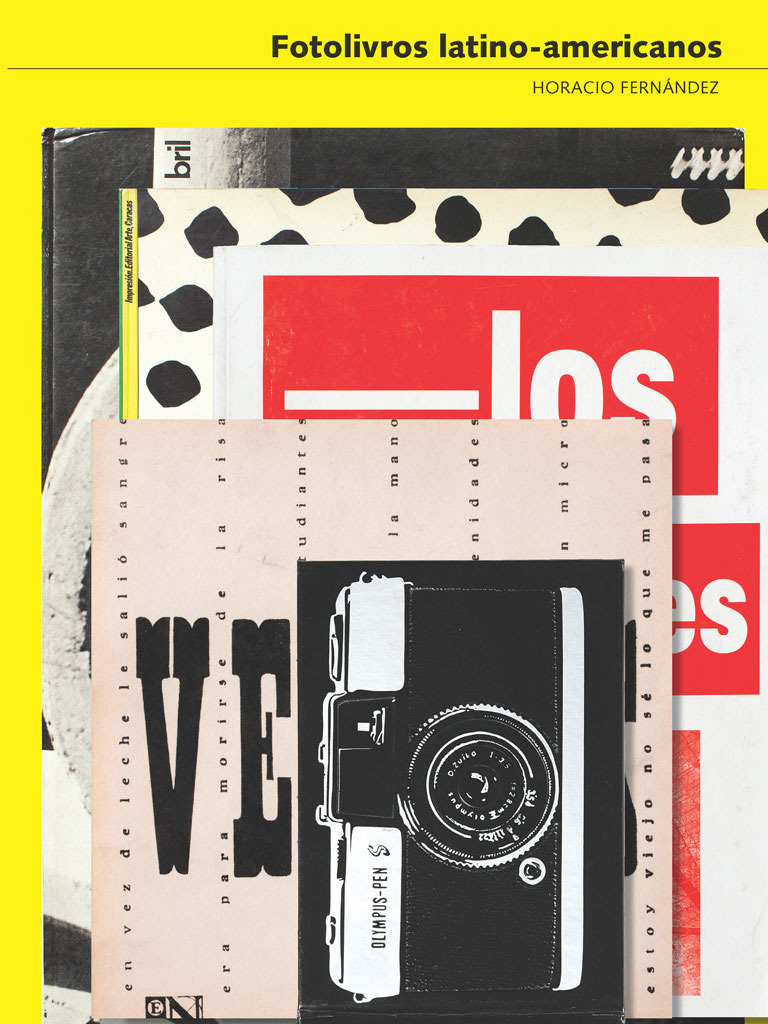“The Spirit of the Times,” Henry Peters Gray, 1861.
In the Spirit of the Times
April 1, 2017Crow Testament
March 31, 2017Andy, Chicago
March 22, 2017Elkins: Pictures and Tears: A History of People Who Have Cried in Front of Paintings
“Of any picture, this is the one that has brought me closest to tears. I may never have actually wept in front of it—it’s been a long time, almost thirty  years—but I remember standing there, choked up, with a rush of half-formed thoughts swimming in my head. When I was thirteen or fourteen, the Ecstasy of St. Francis was almost too much to look at: I recall thinking I could only take in a few details on each visit. It wasn’t a painting, really: it was a dream of what a painting might be. By comparison other pictures were clumsy illustrations where things were, as Beckett put it, ill seen and ill said. Somehow, the Ecstasy of St. Francis resembled the way I thought. It had the right texture, it pooled in the right places. When I looked, it was as if words had been swept out of my head and replaced by brushstrokes and colors. The word “magical” doesn’t do justice to what I felt, but then again I can hardly remember what I felt: I was attached to the painting in a strange fashion that I have nearly lost the ability to recall.”
years—but I remember standing there, choked up, with a rush of half-formed thoughts swimming in my head. When I was thirteen or fourteen, the Ecstasy of St. Francis was almost too much to look at: I recall thinking I could only take in a few details on each visit. It wasn’t a painting, really: it was a dream of what a painting might be. By comparison other pictures were clumsy illustrations where things were, as Beckett put it, ill seen and ill said. Somehow, the Ecstasy of St. Francis resembled the way I thought. It had the right texture, it pooled in the right places. When I looked, it was as if words had been swept out of my head and replaced by brushstrokes and colors. The word “magical” doesn’t do justice to what I felt, but then again I can hardly remember what I felt: I was attached to the painting in a strange fashion that I have nearly lost the ability to recall.”
Elkins, James. Pictures and Tears: A History of People Who Have Cried in Front of Paintings (New York: Routledge, 2001)
Mary Oliver
March 19, 2017Roberta Smith
Final, concluding sentences from an interview with Roberta Smith, by Jarrett Earnest:
Smith: Basically I think opinionated art criticism helps the reader find pleasure and also develop a criticality that can be applied elsewhere. It spills over into other aspects of a person’s life, like thinking critically about architecture or society and what it means to be a citizen.
I’m humbled by art, and I’m always learning from it. It is just amazing to me how hard it is to see, and how little you see. As you grow older you do see more and more but you’re still missing things.
Close Encounters: Roberta Smith with Jarrett Earnest (Brooklyn Rail)
The Beautiful and the Unexpected
“When I was young, and new to modern art, I doted on the Expressionist heads
and faces by the Russian-born artist Alexei Jawlensky, which he painted in
thick layers of clamorous color, and wondered why a bigger deal wasn’t made of them. A flavorsome retrospective of the artist, at the Neue Galerie, renews that appeal. Jawlensky was associated with a group of painters that included, most notably, Wassily Kandinsky, Paul Klee, and Franz Marc, who met in Munich around the turn of the twentieth century. Jawlensky was more a follower than an innovator, having had a  relatively late start as an artist. He was an eighteen-year-old military cadet in Moscow, committed to a career in the tsar’s army and completely ignorant of art, when he was thunderstruck by the paintings in an All-Russian Exhibition of Industry and Art. He later referred to the moment as “a case of Saul becoming Paul,” and said that, since then, “art has been my ideal, my holy of holies.” […]
relatively late start as an artist. He was an eighteen-year-old military cadet in Moscow, committed to a career in the tsar’s army and completely ignorant of art, when he was thunderstruck by the paintings in an All-Russian Exhibition of Industry and Art. He later referred to the moment as “a case of Saul becoming Paul,” and said that, since then, “art has been my ideal, my holy of holies.” […]
“I think now that what excited me about Jawlensky’s heads and faces was the glamour of a secondhand modernist zeal that was easy to identify with and to savor. With similar-looking works by Matisse or Kandinsky, I was daunted by a sense that something more, and beyond me, was going on.” […]
“Jawlensky made about a thousand of these paintings, titled “Meditations,” between 1934 and 1937, in Wiesbaden. The Third Reich had banned exhibitions of his work as “degenerate,” and he was crippled with severe arthritis, which obliged him to use both hands to wield a brush. The pictures meld his innate talents, chiefly for color, with a yearning for transcendence, which had come across as forced or sentimental in earlier work.” […]
“The spirituality was credible enough, though I eventually came to regard Jawlensky’s passion as being more about art than as being fully engaged in it: poignant rather than powerful.” […]
Peter Schjeldahl, “The Beautiful and the Unexpected,” New Yorker, February 27, 2017.
![]()
“The social representations of technologies”
The distinction between the two kinds of knowledge basically corresponds to the Aristotelian distinction between episteme (scientific knowledge) and techne (skill, art or craft). Current philosophical debate (Fantl 2012) concerns whether the two kinds are independent—a position called anti-intellectualism— or whether ’knowing how’ can be reduced to ’knowing that’—a position called intellectualism (see e.g. Stanley 2011). Heyes (2012a) takes this debate further and suggests that neither independence nor reduction is sufficient to understand how these concepts link to processes of social learning. Instead, she emphasizes that it is not visual or motor representation of actions that is important for learning, but the connections between them. These connections do not emerge by themselves—social learning is needed. It is important to notice that the more advanced the learning gets, these connections require different forms of teaching to be achieved.
Here, we also want to distinguish a third kind of knowledge—’knowing what’. ’Knowing what’ concerns the ability to categorize objects, for example to know what kind of tool an object is and what kind of work it is associated with, or what kind of disease somebody is suffering from. ‘Knowing what’ is central in planning a technological activity such as stone knapping: you must know what your goal product is before you start the production process. This kind of knowledge is framed, not just by technology and skills, but by culture. ‘Knowing what’ is socialized and materialized, something discussed by Lemonnier as ‘the social representations of technologies’.
— Högberg, A., Gärdenfors, P., Larsson, L. (2015) Knowing, Learning and Teaching: How Homo Became Docens. Cambridge Archaeological Journal, 25(4): 847-858.
![]()
“Under all that paint in the Tiffany Paintings is everything in the world”
“In an ever-changing world, perhaps Tiffany & Co.’s most consistent relationship with the public over the last century is its daily advertisement on page A3 of The New York Times, which began running in 1896.
“Prince, who began his career in the tearsheet department at Time, Inc., first gained notoriety in the 1980s for his now-iconic Cowboys (lassoed from Marlboro Man ads), The Nurse Paintings (ripped from romance novel covers) and his New Portraits series (featuring images from other people’s Instagram feeds).”
“Under all that paint in the Tiffany Paintings is everything in the world.”
— Richard Prince
Tiffany: The Tiffany Paintings
Prince: The Tiffany Paintings
![]()
Thucydides on human behavior in society
“The field of Thucydides’ investigations was not the nature of the physical universe nor the physical nature of man, but the society of man living in the polis. Politics in the largest sense, the search for an understanding of the behavior of man in society, was his surpassing interest. In this he differed from physical theorists, Sophists and Hippocratics, but their ideas influenced and helped shape his mind. Like all of them, he began with the observation of phenomena and proceeded to discern and describe the rational pattern that emerged. His data were the historical actions of men in the past, remote or very recent. When sufficiently multiplied and properly grasped, these gave rise to general rules of human behavior that might prove useful to men in the future. The student of social behavior—that is, the historian—has a dual responsibility: first to seek out with diligence and accuracy the truth of what has taken place and, then, to interpret the events with wisdom and understanding, in this way making a permanent contribution. To establish the facts (ta erga) was of vital importance but was subordinate to the formulation of interpretations (logoi) that emerged from them.”
— “The student of political behavior: On the enduring legacy of Thucydides”
by Donald Kagan
![]()
Close Reading
Close Reading, 1990
Mark Tansey
‘Tansey’s climber personifies the critic in the grip of the close reading technique, as she strives … her success, and indeed her survival, depends on her ability to read the surface closely. The title also relates to the viewer’s role as a ‘reader,’ who, in order to engage fully the work’s different realities, must read the picture closely.” — Modern Art Museum of Fort Worth 110, 308-09.
Happy Birthday, Kurt Cobain
February 20, 2017A Great City’s People Forced to Drink Swill
February 16, 2017“on behalf of the souls they never knew they saved.”
“A librarian names Miss Truman snatched me from the jaws of ruin and it’s too late now to thank her. I’m not the first person to notice that we rarely get around to thanking those who’ve helped us most. Salvation is such a heady thin the temptation is to dance gasping on the shore, shouting that we are still alive, till our forgotten savior has long gone under. Or else sit quietly, sideswiped and embarrassed mumbling that we really did know pretty much how to swim. But now that I see the wreck that could have been, without Miss Richey, I’m of a fearsome mind to throw my arms around every living librarian that crosses my path, on behalf of the souls they never knew they saved.”
— Barbara Kingsolver, High Tide in Tucson: Essays from Now or Never.
URA QT 2/14
February 13, 2017Nate Silver & truth-seeking behavior
Nate Silver presents his BS-meter — modeled on the old terror alert system — to evaluate information sources and “expertise.”
“Probability is the waystone between ignorance and knowledge. Sometimes the pundit who says ‘I don’t know’ is the one you should trust.”
Ernesto Cardenal, chapel window, Solentiname, Nicaragua (2005)
As pastor of the Solentiname parish, Cardenal facilitated weekly bible studies that encouraged lay parishioners to engage in a theological interpretation of scripture that applied to their own lives. These bible studies served not only to allow ordinary people to connect with scripture, but to also better understand as Christians how to address their experiences of poverty and political repression. Cardenal documented his memories and transcripts of community bible studies in his 1975 publication, El Evangelio en Solentiname (The Gospel in Solentiname). Community “commentaries” occurred often during mass and other times during communal lunches after mass. Many of the dialogues he recorded came from his memory.
However, after he decided to publish these conversations, Cardenal began recording talks with a tape recorder. Thus, while El Evangelio en Solentiname must be understood as a text produced by Cardenal and influenced by his own biases and goals, it nonetheless provides a good suggestion as to the nature of conversations in Solentiname. According to Cardenal’s more recent introduction to the book, “the commentary of these campesinos was usually of greater depth than that of many theologians, but of a simplicity like the gospel itself…the gospel…(the good news to the poor) was written for them, and for people like them.”
The commentary also became a vehicle through which poor campesinos could begin to analyze their own lives both in the context of scripture and in the context of the revolution that was gaining ground in Nicaragua. The revolution and its Marxist orientation did not escape the people who lived in Solentiname. Marxist discourse became a common feature of Sunday discussions, and for this reason many campesinos more fearful of affiliating with subversive groups avoided the church. Still, for those who came, mass with Cardenal became a transformative experience.
A Monastery for the Revolution: Ernesto Cardenal, Thomas Merton, and the Paradox of Violence in Nicaragua, 1957-1979. (2005)
Lake Nicaragua, via National Geographic Magazine, 1899
“Physiography of the Nicaragua Canal Route.” National Geographic Magazine, volume 10, 1899. pages 233-246.
Via Google Maps, 2017.
Susan Sontag
From 2004: “Writer Susan Sontag died Wednesday at age 71 of leukemia. We listen back to two interviews with her: a 1989 conversation about her book AIDS and Its Metaphors; and 1993 interview conducted shortly after Sontag returned from Sarajevo, where she directed a performance of Samuel Beckett’s Waiting for Godot in Serbo-Croatian.”
Twombly’s “Peonies”

In the haiku on the farthest right, the warrior relaxes and takes off his armor, capitulating to pleasure and emotion:
AH! The Peonies
For which
Kusonoki
Took off his Armour
The haiku poet’s name, Kikaku, means “easy-going.” Ironically, Takarai Kikaku (1661-1707), the disciple of the seventeenth-century master of haiku, Matsuo Basho (1644-94), famously dissented from Basho’s philosophy of karumi or “lightness.” Kikaku’s haiku recalls the legendary occasion when the young fourteenth-century samurai warrior Kusunoki Masashige lowered his guard when faced with the beauty of peony blossoms, just before the momentous battle in which he died.
Mary Jacobus. Reading Cy Twombly: Poetry in Paint. Princeton, 2016.
Also via the Art Institute of Chicago:
In Twombly’s inscription, the initial r in the word armour is smaller than the other letters and was thus likely inserted by the artist as a revision or made to appear as an intentional afterthought. This perhaps intentional pun on the terms amour/armour further conflates the themes of love and violence that shape Kusunoki’s story.
Mark Twain sees Ometepe, Nicaragua, 1866
“Out of the midst of the beautiful Lake Nicaragua spring two  magnificent pyramids, clad in the softest and richest green, all decked with shadow and sunshine, whose summits pierce the billowy clouds. They look so isolated from the world and its turmoil — so tranquil, so dreamy, so steeped in slumber and eternal repose. What a home one might make among their shady forests, their sunny slopes, their breezy dells, after he had grown weary of the toil, anxiety and unrest cf the bustling, driving world.”
magnificent pyramids, clad in the softest and richest green, all decked with shadow and sunshine, whose summits pierce the billowy clouds. They look so isolated from the world and its turmoil — so tranquil, so dreamy, so steeped in slumber and eternal repose. What a home one might make among their shady forests, their sunny slopes, their breezy dells, after he had grown weary of the toil, anxiety and unrest cf the bustling, driving world.”
“These mountains seem to have no level ground at their bases, but rise abruptly from the water. There is nothing rugged about them— they are shapely and symmetrical, and all their outlines are soft, rounded and regular. One is 4,200 and the other 5,400 feet high, though the highest being the furthest removed makes them look like twins. A stranger would take them to be of equal altitude. Some say they are 6,000 feet high, and certainly they look it. When not a cloud is visible elsewhere in the heavens, their tall summits are magnificent: draped with them. They are extinct volcanoes, and consequently their soil (decomposed lava) is wonderfully fertile. They are well stocked with cattle ranches, and with corn, coffee and tobacco farms. The climate is delightful, and is the healthiest on the Isthmus.”
Sandwiches, Etc.
“Our boat started across the lake at 2 p. m., and at 4 a. m. the following morning we reached Fort San Carlos, where the San Juan River flows out — a hundred miles in twelve hours — not particularly speedy, but very comfortable.”
Daily Alta California, Volume 19, Number 6210, 16 March 1867. Page 1, “Letter from Mark Twain.”
 Concepción volcano, Ometepe, 2016
Concepción volcano, Ometepe, 2016
View via Google Maps
“… the perpetual stumble of conjecture”
 “The angels themselves, in whom no disorder is feared, are distinguished and quarternioned into their celestial princedoms and satrapies. How much less can we believe that God would leave his frail and feeble, though not less beloved church here below, to the perpetual stumble of conjecture and disturbance in this our dark voyage, without the card and compass of discipline?”
“The angels themselves, in whom no disorder is feared, are distinguished and quarternioned into their celestial princedoms and satrapies. How much less can we believe that God would leave his frail and feeble, though not less beloved church here below, to the perpetual stumble of conjecture and disturbance in this our dark voyage, without the card and compass of discipline?”
John Milton, The Reason of Church-Government urg’d against Prelaty. The Reason of Church-Government urg’d against Prelaty by Mr. John Milton. In Two Books. [1641]
Elkins’s footnote on graphs & timelines
From footnote #5, Theorizing Visual Studies — “How to Use This Book”:
5. The graph is heuristic rather than quantifiable. In general, graphs are understood as purely informational objects, whose task is to communicate sometimes intricate data fields in formats that are pleasing, memorable, and immediately comprehensible. In keeping with this book’s critical intentions, some graphs and time lines behave more like art objects in the specific sense that they also contain forms that cannot be read. In this case, the graph mingles commonly made connections with speculative ones. It also contains signs, such as the extra dots at the upper left and the variety of left- and right-handed arrowheads, whose significance is not explained. The idea is to let the graph work more broadly, more openly, so that it can suggest information and ideas instead of merely illustrating data.
Elkins, James. Theorizing Visual Studies (5-6) 2012.
Black Friday, Chicago
November 25, 2016J.S. Curry: “Our Good Earth”
“One of the best-known works that is on view, “Our Good Earth” (1940-42), 52 by 40 inches, nicely represents Curry’s approach, especially the mythic quality so important to his work. The oil and tempera on canvas depicts a muscular farmer, clad in overalls, standing hip-deep in a wheatfield with his two young children. Cottony clouds and wispy wheat are rendered with soft brushwork. Despite the scene’s bucolic nature, the farmer has a troubled look on his sideways-looking face, perhaps a harbinger of an unseen approaching storm or a metaphor for the country’s impending entry into World War II.”
WSJ: The Forgotten Regionalist: A Flawed But Compelling Artist Who Has Yet to Get His Due
The painting was later remediated as a War Bonds poster (1942-3)
Sandra Cisneros: “An Altar for My Mother”
National Museum of Mexican Art, Chicago, November 2016: #30 Día de los Muertos: Journey of the Soul.
Previous version, with different arrangement (2015): A Room of Her Own: An Altar for My Mother, an installation by Sandra Cisneros.
Ometepe, Nicaragua, 2015
November 13, 2016“Consensus and Ideology in American Politics” (1964)
Herbert McClosky. 1964. “Consensus and Ideology in American Politics.” American Political Science Review 58 (June): 361–82.
Normalizing
“Hitler’s team worked with global media to normalize him–meticulously reworking his image from an oddball with few family ties to a statesman”
Via Adam Khan on Twitter.
Noticia en el supermercado
Hablan del supervisor, reniegan de los turnos,
de si la fulanita no llegó a tiempo,
del mísero sueldo que para nada alcanza.
en la carretera frente a mi casa.
Acababa de bajarse del bus una muchacha
y una camioneta la mató
cuando intentaba cruzarse al otro lado.
Un gentío rodeaba su cadáver
y algunos comentaban conmovidos
que no parecía tener más de dieciocho años.De repente cesa la habladera.
Alguien dio la noticia
que se regó como un temblor oscuro y sordo
por el supermercado.
¿Cómo decirle a doña Mariana que su única hija
que tanto le costó,
que apenas iba a matricularse en la universidad,
y se despidió tan contenta esta mañana,
yace en media carretera con el cráneo destrozado
mientras ella despacha muy amable la carne a los clientes?
English version
“News in the Supermarket”
I hear them gossiping among the vegetables:
they are talking about their supervisor,
grumbling about their shifts, so and so was late
and their rotten wages that don’t go anywhere.
Early this morning there was an accident
on the road in front of my house.
A girl stepped off the bus
and a lorry killed her
as she was trying to cross to the other side.
A crowd gathered round her body
and some remarked painfully
that she seemed no more than eighteen.
Suddenly the gossip stops.
Someone has brought the news
which runs through the supermarket
like a muffled tremor.
How to tell Doña Mariana that her only daughter
for whom she has struggled so hard,
who was just about to start at university,
who was so happy when she said goodbye that morning,
is lying in the middle of the road with a smashed skull
while she is amiably serving customers with meat.
— Daisy Zamora
Basilica of St. Benedict, Norcia
In Norcia, a city that considers itself the birthplace of pork sausages, three of the most important churches were heavily damaged.
[…]
In Norcia, closest to the epicenter, friars and devotees gathered in the piazza to kneel and pray after the earthquake, photos by the Italian daily La Repubblica show.
“There is something here almost more important than the value of the single paintings that was lost today,” said Philippe Daverio, an Italian art critic and author. “What’s equally important here is that Benedict, the patron saint of Europe, and his sister Scholastica, were born in Norcia. These two twins changed the framework of the West by inventing monastic group life and the ‘rule.’ ” Daverio was referring to the Latin phrase “ora et labora,” which means “pray and work.”
- WAPO: Latest Italian earthquake devastates medieval churches and other sites
- La Repubblica: Repubblica.it: Terremoto, scossa 6.5 nel Centro Italia: le immagini [click on slideshow]
- Telegraph, UK: Local priests told to hold mass outdoors after 6.6 quake destroys historic cathedral in Norcia
The Basilica of St. Benedict is destroyed, flattened by most recent earthquake. #Terremoto pic.twitter.com/GQDl64LhFn
— The Monks of Norcia (@monksofnorcia) October 30, 2016
How to make friends
October 25, 2016Latin American Photobook
October 24, 2016Davis & Yancey on Materiality
“These three stories, however, were not immediately apparent to me when I initially encountered the scrapbook, which I found on the web, and like any good web reader, I invented my own progress through the materials. In other words, my reading of the scrapbook did not follow the linear logic of the physical scrapbook, but rather, linking my way through scrapbook pages digitally unhinged from the scrapbook frame, it followed the logic of the web (Yancey, 2004). The logic of the physical scrapbook—like the logic of the book and indeed of print portfolios—is remediated on the book: like the book, a scrapbook in its physical form “proceeds in a linear fashion from beginning to end” (Yancey, 2004, p. 748). It privileges the composer’s perspective, and although in theory a reader may move through a scrapbook hypertextually, the linear arrangement of the scrapbook argues for a beginning-to-end reading.”
Davis, Matthew, and Kathleen Blake Yancey. “Notes Toward the Role of Materiality in Composing, Reviewing, and Assessing Multimodal Texts.” Computers and Composition 31: 13-28.
Summerfield: Oxford Pictures 1968-1978

“Often, I sensed a loneliness in the students I photographed. We were all lonely together.”
Paddy Summerfield: Oxford Pictures 1968-1978
Nervous Cormorants

“It is not entirely clear why cormorants are such prodigious vomiters. Like many birds, they feed their young regurgitated fish, but they also vomit when approached by predators — perhaps to drop weight in preparation for flight, but possibly also to distract their predators. There is also, said John Waldman, a Queens College biology professor and Mr. Grubel’s thesis adviser, the ‘nervousness theory’.”
Good morning
October 21, 2016Franz Marc: Yellow Cow

The continual artistic interchanges while the almanac and the exhibition were in preparation helped to focus and intensify the form and colour of Marc’s work, and increased its expressive power. He sought to reduce the natural multiplicity of detailed forms to an almost geometrical simplicity, as is seen inYellow Cow (1911; New York, Guggenheim), Small Blue Horses (1911) and Small Yellow Horses (1911; both Stuttgart, Staatsgal.).
. “Marc, Franz.” Grove Art Online. Oxford Art Online. Oxford University Press. Web. 19 Oct. 2016.<http://www.oxfordartonline.com.ezproxy.depaul.edu/subscriber/article/grove/art/T054182>.
Noemi Álvarez Quillay
In one class, some of us clipped this image and the accompanying article so that we could carry it with us and help to protect against forgetting.

Context:
- Noemi: Another Sad Border Story | The Range
- Al encuentro de la muerte: el caso de Noemí Álvarez | SubVersiones
- Case of Noemí Álvarez Quillay — International Tribunal of Conscience of Peoples In Movement: First Hearing on the Human Rights Crisis in Mexico (page 9)
Issa via Hass
Don’t worry, spiders,
I keep house
casually.
New Year’s Day—
everything is in blossom!
I feel about average.
The snow is melting
and the village is flooded
with children.
Goes out,
comes back—
the love life of a cat.
Mosquito at my ear—
does he think
I’m deaf?
Under the evening moon
the snail
is stripped to the waist.
Even with insects—
some can sing,
some can’t.
All the time I pray to Buddha
I keep on
killing mosquitoes.
Napped half the day;
no one punished me!
The Essential Haiku: Versions of Basho, Buson, and Issa, edited and with an introduction by Robert Hass, 1994.
Plants making love
It is noteworthy that in all languages the greater part of the expressions relating to inanimate things are formed by metaphor from the human body and its parts and from the human senses and passions. Thus, head for top or beginning; the brow and shoulders of a hill; the eyes of needles and of potatoes; mouth for any opening; the lip of a cup or pitcher; the teeth of a rake, a saw, a comb….
Heaven or the sea smiles; the wind whistles; the waves murmur; a body groans under great weight. The farmers of Latium used to say the fields were thirsty, bore fruit, were swollen with grain; and our rustics speak of plants making love, vines going mad, resinous trees weeping. Innumerable other examples could be collected from all languages. All of which is a consequence of our axiom that man in his ignorance makes himself the rule of the universe, for in the examples cited he has made of himself an entire world.
So that, as rational metaphysics teaches that man becomes all things by understanding them (homo intelligendo fit omnia), this imaginative metaphysics shows that man becomes all things by not understanding them (homo non intelligendo fit omnia); and perhaps the latter proposition is truer than the former, for when man understands he extends his mind and takes in the things, but when he does not understand he makes the things out of himself and becomes them by transforming himself into them.
Giambattista Vico, The New Science of Giambattista Vico §405 (Thomas Goddard Bergin and Max Harold Fisch trans.) (Ithaca: Cornell U. Pr., 1948 [1744].
Henry Rollins on Travel
October 12, 2016Girl with pink hair reflects on girl with a green face
October 9, 2016Marilynne Robinson: Save our Public Universities

… It obscures the fact that there is a vast educational culture in this country, unlike anything else in the world. It emerged from a glorious sense of the possible and explored and enhanced the possible through the spread of learning.
If it seems to be failing now, that may be because we have forgotten what the university is for, why the libraries are built like cathedrals and surrounded by meadows and flowers. They are a tribute and an invitation to the young, who can and should make the world new, out of the unmapped and unbounded resource of their minds.
From “Save Our Public Universities,” March, 2016
Social Documentary Photography
“The third in a trio of photographers that redefined social documentary photography in the 1960s was Lee Friedlander (born 1934). While Winogrand constructed existential situations with his camera and Arbus analyzed the inhabitants of the era with her lens, Friedlander sought to understand his era by examining society’s cultural furniture. In Nashville (1995.168.2), the television becomes a surrogate for humanity, dramatizing the unsettling idea that all experience—even our sense of self—is dwarfed by the power of media. Friedlander also inserted himself into his photographs using shadows and reflections, as in Colorado (1993.360), in effect transforming a street photograph into a self-portrait that attempts to ferret out the significance of individuality within the flotsam and jetsam of an increasingly mediated world.”
Also see:





















































